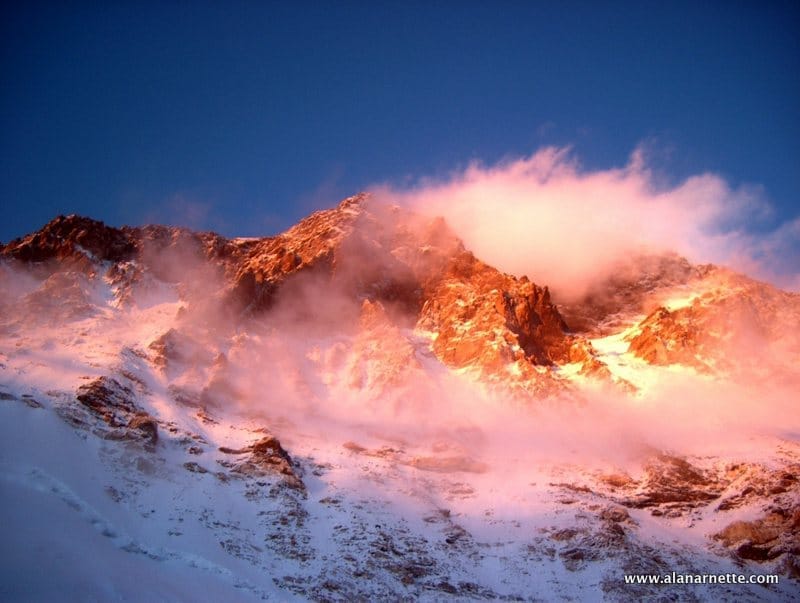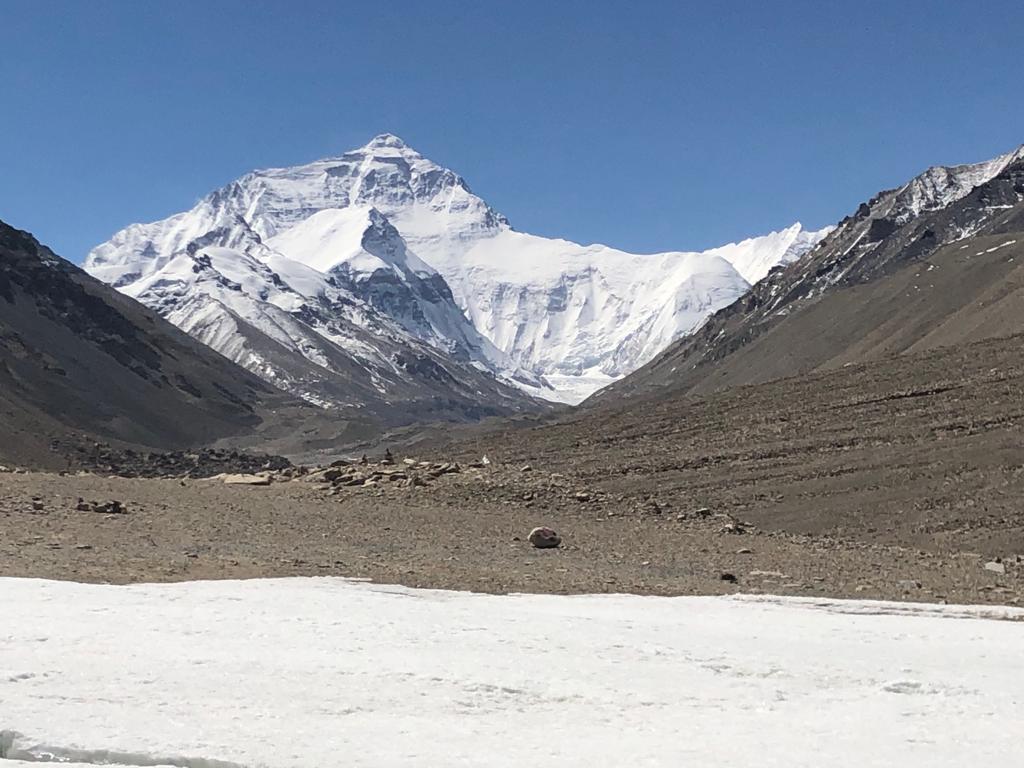
Looks like high winds are putting a crimp in everyone’s schedule. The Sherpas have stopped fixing the line just above the Yellow Band on the South and most of the North teams have reed back to their base camp.
High winds are not totally unusually for the end of April but it makes everyone very anxious wanting to check the box for their night at Camp 3 or the North Col. Remember this is just half time so lots of climbing days left.
There were many updates overnight so I have a lot of quotes and encourage you to click on the links to read the entire post and see their pictures.
Health and Services
I commented yesterday that 30 people had been helicoptered out of EBC. Now EverestER, the fantastic volunteer team of Doctors who support Base Camp-South each season, ambulance posted this today:
It’s been a wild ride of emotion and activity over the past week. Between dangerous avalanches and just plain illness, we’ve been busy (over 250 s in our first 3 weeks of opening) and emergency cases and evacuations have reached an all-time high for the . We’re not sure quite what accounts for this unusual acuity – probably several different factors contribute, including more trekkers overnighting in base camp (more folks novice to sleeping at such high altitude and the complications that ensue), more teams signing on for our service, a warm and unstable season, a particularly treacherous icefall route, and more helicopters than we’ve ever seen available for quick response.
An update on Cory Richards, attempting the West Ridge with NatGeo’s Conrad Anker. The helicopter service, Fishtail Air, reports he is in Lukla and will be flown to Kathmandu tomorrow. Further reports suggest he suffered a pulmonary embolism, blockage in his lungs, likely from blood clot; and not AMS.
Helicopters
One point on the helicopters. In the “old” days, 2008 and earlier, the Nepal Army was the dominate provider of helicopter services for climbing expeditions. It was dangerous, difficult, expensive and took a lot of work to arrange an evacuation. Today, a private company, Fishtail Air, appears to have taken over many of the evacuations with their 5 helicopter fleet. These high altitude helicopters include the Eurocopter AS350 Ecureuil aka Squirrel. In 2005, a stripped down B3 touched it’s landing pads on the summit of Everest, making history.
While not a tourist flight in Hawaii, it is slightly safer and much easier and more reliable than the Army. The Army still helps with large load transport. I wrote an article in 2010 on Fishtail that examines helicopter services in Nepal. Today they land at Camp 2 in the Western Cwm, but not higher. It costs around USD$7,000 per flight and is very weather dependent.
Weather
Adventure Consultants delayed their climb to camp 3 due to weather:
The jet stream continues to blast the tops of Lhotse and Everest and all night our tents were shaken violently by the descending gusts. Under the current conditions a journey up the Lhotse Face to C3 is out of the question, so tomorrow we plan a trek up the Western Cwm to the base of the Face to reinforce our acclimatization. Meanwhile we wrap up well against the wind and cold, many of us deciding to wear our down suits around the camp.
Leanna Shuttleworth with AAI is back at Camp 2 and posted her thoughts on the night at Camp 3:
This next rotation will be all the way up to Camp Three, and spending a night there without oxygen. We’ve all heard horror stories about this night there, and can’t say we’re looking forward to it particularly! Sleep sounds elusive and the altitude will most definitely make itself known. Team members who might not benefit from this night may be just “touching” Camp Three before descending for the night in Camp Two instead.
Along these lines, I have added a new symbol in the location table of a “T”. So the letters mean” e= climb ended, x=last reported location, x+ = on summit bid, -x = descending, h=high sleep point, T=touched not slept. The legend is under the table.
There are different thoughts on spending the night versus spending hours at an extreme higher altitude such as Camp 3 (24,000/7300m) for acclimatization purposes. Obviously the difference is time. The longer you spend, the more the body adjusts but also degrades, the less time spent you retain strength but don’t generate as many red blood cells, presumably. It would be interesting to take blood tests to compare the different techniques. The world-class climbers usually spend the night, for what it is worth. But one point overrides the discussion of hours in that it takes the body weeks, not hours to fully adjust to a new altitude completely so all of this may be a moot point.
More Weather
Onto more reports with everyone talking weather:
Don’t miss Grant Rawlinson’s pictures of Chinese Base Camp on the north. He posted some great shots.
Dave Hahn on his way to Camp 2, phoned in a report on the wind and lack of snow up high:
The climbing route is ok but kind of spooky. We walked thru some very large debris fields from avalanches that have come down in the last couple of days from both the West Shoulder of Mt. Everest and from Nuptse. Both mountains have thrown down debris that is across the climbing route. We didn’t have a bad day, we were pretty lucky with our conditions. It was kind of a breezy day and they say the jet stream is right over Mt. Everest right now. The weather we are experiencing certainly seems to bear that out. It was sunny, cold and gusty and windy most of the day but that saved us from being too hot coming up into camp, this big reflector oven of the Western Cwm. Thing are really dry up here.
Likewise, Kurt Wedberg comments on life at EBC along with a few excellent quality pictures:
Weather has been pretty typical for April in the Himalayas. Night time temperatures dip into the teens or low 20s. During the daytime the mornings are clear, sunny, and usually very pleasant with little to no wind. Most afternoons see the skies turn partly cloudy. Occasionally it will cloud over enough for light snow to fall. The ridge lines above 7000m or 24,000? have been getting hit by strong winds of 60+ mph, which is typical for this time of year. Recently at Base Camp we have seen the first signs of the coming spring. Temperatures are starting to gradually warm up and the sun is peaking over the ridge tops a little earlier each morning.
Ian Ridley comments on life at EBC calling it luxurious. Interesting how perspectives change after spending time at Camp2 ! He also notes how well he feels as measured by observing trekkers. he is not being mean, it is a fact that by now the climbers feel like world class athletes when they are back at base camp:
Now this is going to sound awful but it was quite entertaining to see trekkers struggling up the trail hunched over their walking poles and not having the energy to say hello or to even raise a smile! Mind you I’m sure that’s what we looked like three weeks ago and no doubt will look like on our way up to camp three. Time wise up and down was an hour and a quarter, virtually the same as last time, but it felt easier so hopefully there are a few more red blood cells inside me now.
Ian updated this morning that they delayed their climb to Camp 3:
That’s now been delayed by a day due to high winds higher up on the mountain. Our Sherpas have been unable to cut the ledges for our tents at Camp Three whilst other Sherpas from a combination of teams set off this morning to continue fixing the lines up to the South Col but were beaten back by the strong winds.
Everest is about patience …
Climb On!
Alan
Memories are Everything




2 thoughts on “Everest 2012: Helicopters and Wind Delays”
There may be a lot of inactivity owing to the strong winds but your colourful blog has left us with so many avenues to explore and lots of food for thought. It must be hard having patience when you see what’s in front of you every day. Has it ever occurred that a season came and went without anyone who had prepared for a summit climb were unable to go for it because of the weather conditions? Cheers Kate (N Yorks )
Thanks as always Kate. A total shutout is rare on Everest but in 2005, it had people wondering when the jetstream sat on the summit throughout early May forcing the latest first summit day in 45 years of climbing Mt. Everest, May 21st. Norgay and Hillary did it on May 29, the earliest was April 4 in 1984. One reason some people prefer the north is the Icefall Doctors stop maintaining the route on May 31 due to melting issues thus creating a hard stop. There is no such deadline on the north allowing climbs until the monsoon moves in shutting things down which can be mid June.
Comments are closed.